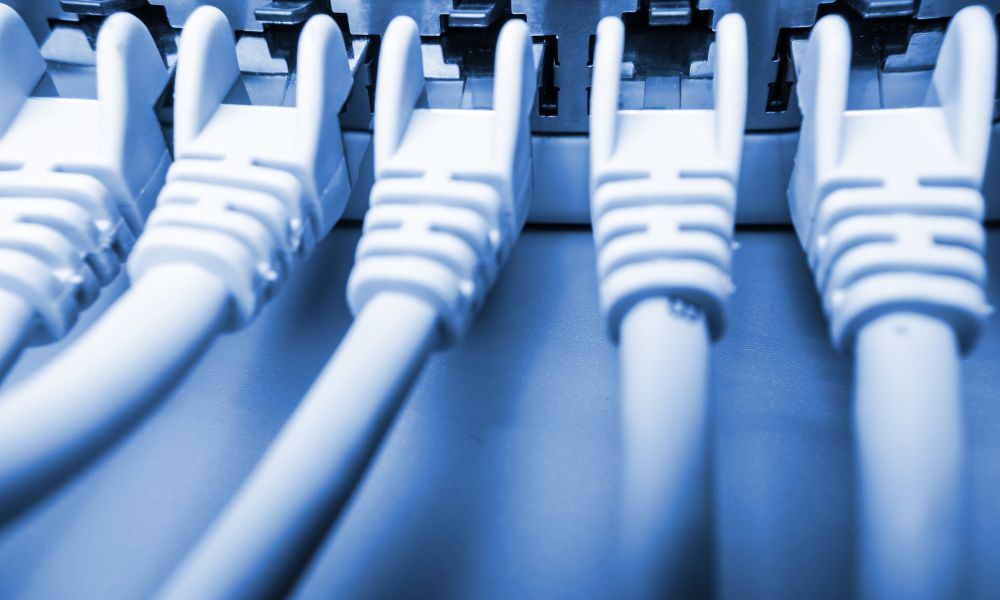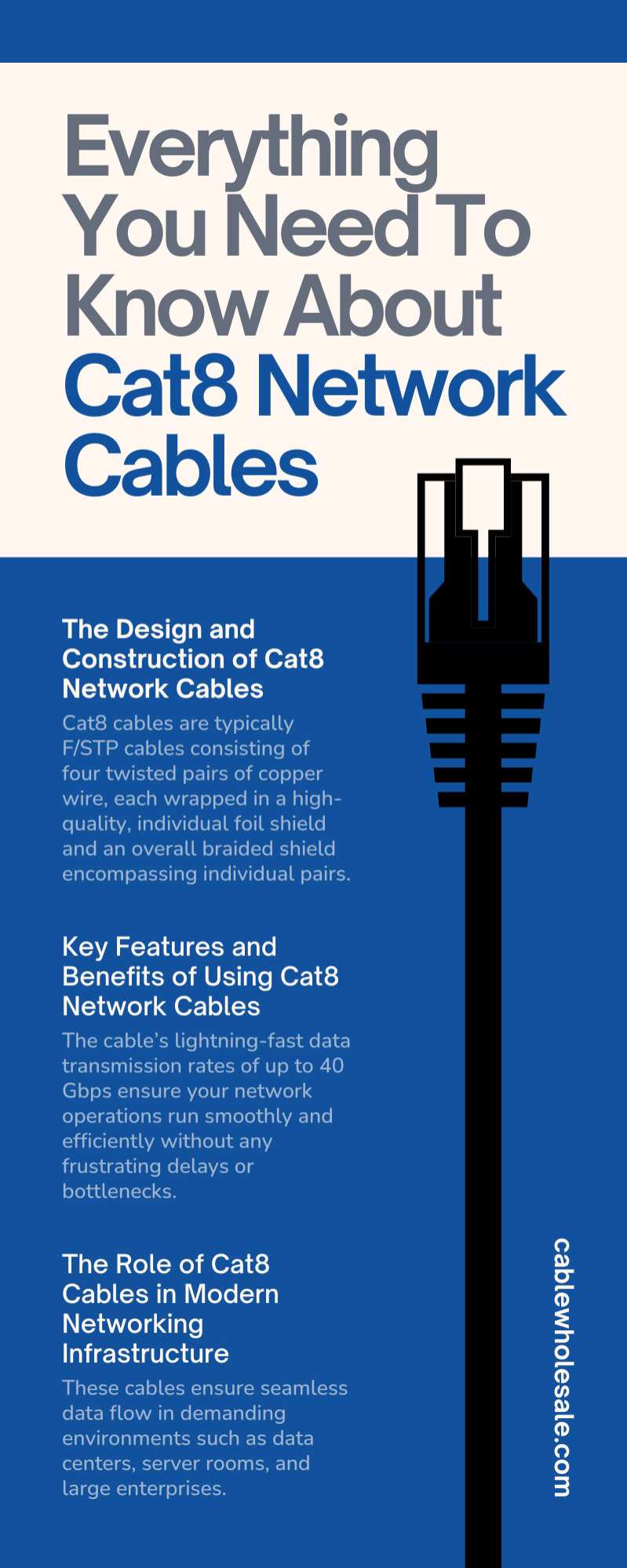
When it comes to setting up a secure, high-speed network, Cat8 network cables are the latest and greatest in the industry. These cables represent the pinnacle of ethernet technology, offering unparalleled benefits, and understanding them provides knowledge for improving your network. Discover everything you need to know about Cat8 network cables and catapult your network’s performance to unprecedented levels.
The Evolution of Network Cables
The journey of network cables began with Category 1 (Cat1), primarily used for telephone line communications, and has evolved significantly over the years. Introducing Category 5 (Cat5) cables marked a revolutionary step in this evolution, providing speeds from 10 to 100 Mbps. Soon after, we saw the advent of Category 5 Enhanced (Cat5e) cables that boosted the data transmission rate, helping it reach up to 1 Gbps.
The subsequent introduction of Category 6 (Cat6) and Category 6a (Cat6a) cables pushed the boundaries further, supporting frequencies up to 500 MHz and data rates up to 10 Gbps. With each new iteration, the network cable industry saw a notable enhancement in data transmission rates, noise cancellation, and overall performance.
The Technical Specifications of Cat8 Network Cables
Cat8 network cables have extensive technical specifications that set them apart from their predecessors. These cables come with a whopping frequency support of up to 2 GHz and transmit data up to 40 Gbps.
They have superior shielding that reduces noise and interference, ensuring optimal data transmission. With a reach of up to 30 meters, Cat8 cables offer more than just high-speed data transmission—they promise consistency and stability, too.
These cables are future-proof and ready to meet the challenges of ever-evolving tech landscapes. The unparalleled potential of Cat8 network cables makes them the perfect choice for your network infrastructure.
The Design and Construction of Cat8 Network Cables
The physical design and construction of Cat8 network cables contribute significantly to their exceptional performance. Cat8 cables are typically F/STP cables consisting of four twisted pairs of copper wire, each wrapped in a high-quality, individual foil shield and an overall braided shield encompassing individual pairs.
This shielding provides additional protection and enhances signal integrity. Cat8 cables also follow the stringent ANSI/TIA-568-C.2-1 standard for performance, ensuring they meet the high demands of modern network infrastructure.
Key Features and Benefits of Using Cat8 Network Cables
Cat8 network cables offer numerous impressive features that make them indispensable to any modern network setup. Their lightning-fast data transmission rates of up to 40 Gbps ensure your network operations run smoothly and efficiently without any frustrating delays or bottlenecks.
The robust shielding techniques in their design minimize noise and interference, guaranteeing that your data gets where it needs to go without any errors or interruptions. Their reach of up to 100 feet offers flexibility and versatility in setting up your network infrastructure.
The Role of Cat8 Cables in Modern Networking Infrastructure
In today’s data-driven world, Cat8 cables play a pivotal role in modern networking infrastructure. One important thing to understand about Cat8 cables is their importance in robust, high-speed networks. These cables ensure seamless data flow in demanding environments such as data centers, server rooms, and large enterprises.
Their superior data transmission rates, robust shielding against interference, and adherence to rigorous performance standards make them the go-to choice for professionals seeking high-performance networking solutions. Integrating these cables into your network setup will elevate your current network performance and future-proof your infrastructure against rapid technological advancements.
Comparing Cat8 Network Cables With Other Categories
Before Cat8 cables, previous iterations such as Cat5, Cat5e, Cat6, and Cat6a each brought advancements in speed and performance, but none matched this cable’s capabilities. While the older categories served well in their time, they cannot compete with the consistency and stability of the meticulously designed Cat8 cables. Whether it’s a small-scale business or a large data center, the unmatched performance of Cat8 cables makes them the most advanced choice for any network infrastructure.
Practical Applications of Cat8 Network Cables in Various Industries
Cat8 cables are instrumental in diverse industries, driving efficiency and performance to new heights. The high-speed, reliable data transfer provided by Cat8 cables supports timely, effective patient care in the healthcare sector, which has an increasing reliance on telemedicine and real-time patient data transmission.
Within the finance industry, where milliseconds mean the difference between profit and loss, Cat8’s unparalleled data transmission rates enable lightning-fast trades and transactions. These cables also facilitate seamless, lag-free virtual learning experiences in academia, allowing for real-time knowledge sharing and collaboration. Finally, in the media and entertainment industries, where high-resolution, real-time streaming is the norm, Cat8 cables deliver consistent, high-quality transmissions.
How To Properly Install and Maintain Cat8 Network Cables
The proper installation and maintenance of Cat8 network cables are crucial for maximizing their performance and longevity. As with other network cable installations, ensure the environment is free from electrical interference and use high-quality connectors that match the caliber of the Cat8 cables. Carefully uncoil the cables without twisting or bending excessively, as this compromises their performance.
Once installed, perform regular check-ups for any physical damage or loose connections to keep the network running smoothly. Keep the cables away from sharp edges and corners, and avoid tightly bundling them to prevent potential damage. Regular software updates and checks for data losses or slowdowns will also help maintain the top-notch performance of Cat8 Network Cables.
Common Troubleshooting Tips for Cat8 Network Cables
In the event of encountering issues with your Cat8 cables, there are several common troubleshooting steps to diagnose and potentially resolve the problem. First and foremost, check the physical status of the cables. Look for any visible damage, such as cuts, kinks, or severe bends, as these could affect the cable’s performance.
Inspect your connectors to ensure they are properly inserted and secured. Loose or improperly inserted connectors drastically impact data transmission rates. Test the cable with a cable tester, a handy tool that identifies issues such as incorrect wiring, bad connections, or signal interference.
Additionally, consider the network equipment linked to your Cat8 cables. Sometimes, the issue may be outdated or incompatible network devices, not the cable.
Why Cat8 Cables Are a Solid Investment
Investing in Cat8 network cables is a strategic decision that brings remarkable dividends in the long term. These cables keep pace with rapid technological advancements, ensuring your network infrastructure remains relevant, efficient, and high-performing for years.
The Cat8 cable’s robust construction and superior technical specifications render them capable of handling the rigorous demands and high data traffic of modern network environments. Regardless of how extensive your business is, investing in Cat8 cables equips you with a formidable tool that drives improved performance, speed, and reliability.
Cat8 network cables are a robust and reliable solution for modern networking needs in the rapidly evolving technological landscape. With their exceptional speed, advanced shielding mechanisms, and adherence to industry standards, they are primed to meet the challenges of high-traffic network environments. Embrace the potential of Cat8 and ensure your network infrastructure is ready to keep pace with the inevitable march of technological advancement.




